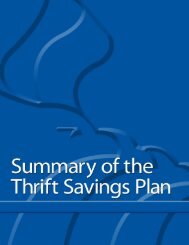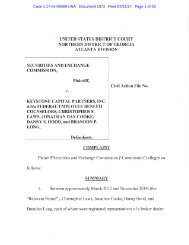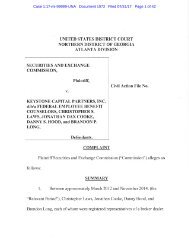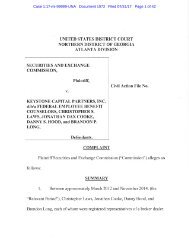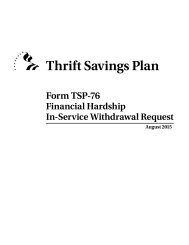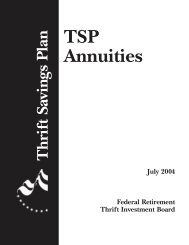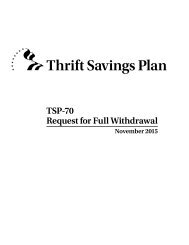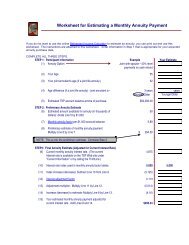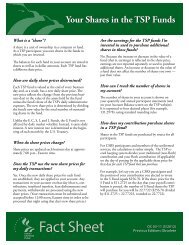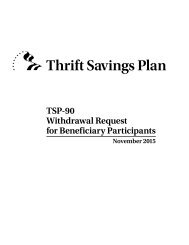TSP Loans
Create successful ePaper yourself
Turn your PDF publications into a flip-book with our unique Google optimized e-Paper software.
Table of Contents<br />
Things to Consider Before You Borrow ..................... 1<br />
Rules for Borrowing....................................... 2<br />
Applying for a Loan ....................................... 6<br />
Repaying a Loan........................................... 8<br />
Taxable Distribution ..................................... 10<br />
Appendix I<br />
How Nonpay Status Affects Your <strong>TSP</strong> Loan ................. 13<br />
Appendix II<br />
Requirements for Residential Loan Documentation. . . . . . . . . .16<br />
Appendix III<br />
Checklist for Making Additional Loan Payments............. 19
Things to Consider<br />
Before You Borrow<br />
The Thrift Savings Plan was designed to provide you with income after<br />
you retire. The amount you will have in your account at retirement depends<br />
on the decisions you make — how much you contribute, how you invest,<br />
and whether you take money out of your account — before you retire.<br />
The <strong>TSP</strong> loan program is an important benefit that allows participants<br />
access to the money in their accounts. However, taking a loan could result<br />
in less money for you at retirement. So, before you borrow from your account,<br />
consider the following:<br />
•<br />
•<br />
•<br />
If your <strong>TSP</strong> investments earn higher rates of return than the interest<br />
rate on the loan, your <strong>TSP</strong> account will end up being smaller than it<br />
would have been if you had not borrowed from it.<br />
If you are not able to contribute as much to the <strong>TSP</strong> because of the<br />
financial burden of your loan payments, your <strong>TSP</strong> account will not<br />
grow as quickly. If you are a FERS employee and you have to reduce<br />
your contribution rate to below 5%, you will not receive the full<br />
agency match.<br />
A <strong>TSP</strong> residential loan is not a mortgage. Therefore, the <strong>TSP</strong> loan<br />
interest payments are not tax deductible, as they might be for a<br />
mortgage or home equity loan.<br />
Before you take a <strong>TSP</strong> loan, read this booklet in its entirety to make sure<br />
you realize the potential effect a loan has on your retirement income.<br />
1
Rules for Borrowing<br />
You can borrow from your account if:<br />
•<br />
You have at least $1,000 of your own contributions and asso ci ated<br />
earnings in your account. Agency contributions (and earnings on<br />
that money) cannot be borrowed.<br />
• You are currently employed as a Federal civilian employee or member<br />
of the uniformed services. (Separated or retired participants and<br />
beneficiary participants are not eligible.)<br />
• You are in pay status. (Loan payments are deducted from your pay.)<br />
• You have not repaid a <strong>TSP</strong> loan (of the same type) in full within<br />
the past 60 days.<br />
•<br />
You have not had a taxable distribution on a loan within the past<br />
12 months, unless the taxable distribution resulted from your separation<br />
from Federal service. (See page 10 for more information on<br />
taxable distributions.)<br />
You can borrow from your <strong>TSP</strong> account even if you have stopped contributing<br />
your own money.<br />
If you have both a civilian account and a uniformed<br />
services account, the eligibility requirements apply<br />
to the account from which you intend to borrow.<br />
There are two types of loans:<br />
•<br />
•<br />
General purpose loan with a repayment period of 1 to 5 years. No<br />
documentation is required.<br />
Residential loan with a repayment period of 1 to 15 years. Documentation<br />
is required. See Appendix II.<br />
A residential loan can be used only for the purchase or construction<br />
of a primary residence. The residence can be a house, condominium,<br />
shares in a cooperative housing corporation, a townhouse, boat,<br />
mobile home, or recreational vehicle, but it must be used as your<br />
2
primary residence. The residence must be purchased (in whole or<br />
in part) by you. You can obtain a residential loan for constructing<br />
a new residence or purchasing an existing residence, but not for<br />
refinancing or prepaying an existing mortgage, for renovations or<br />
repairs, for buying out another person’s share in your current residence,<br />
or for the purchase of land only.<br />
You may have only one general purpose loan and one residential loan<br />
outstanding at any one time.<br />
Minimum loan amount. The smallest amount you can borrow is $1,000<br />
of your own contributions and earnings.<br />
Maximum loan amount. The maximum loan amount you can borrow is<br />
the smallest of the following:<br />
(1) Your own contributions and earnings on those contributions in<br />
the <strong>TSP</strong> account from which you intend to borrow (civilian or<br />
uniformed services), not including any outstanding loan balance<br />
(the Contributions and Earnings Test);<br />
(2) 50% of your total vested account balance (including any outstanding<br />
loan balance) or $10,000, whichever is greater, minus any outstanding<br />
loan balance (the Internal Revenue Service (IRS) Vested<br />
Balance Test); or<br />
(3) $50,000 minus your highest outstanding loan balance, if any, during<br />
the last 12 months (the IRS $50,000 Test). Even if the loan is<br />
currently paid in full, it will still be considered in the calculation<br />
if it was open at any time during the last 12 months. For<br />
example, if you took out a loan for $35,000, then paid the loan back<br />
in full within 12 months, the maximum loan amount you would be<br />
eligible to borrow would remain $15,000 ($50,000 minus $35,000,<br />
the highest outstanding balance during the last 12 months) even<br />
though the money has been returned to your account. Note: The<br />
above example is based on the assumption that the IRS $50,000<br />
Test is the lower of the three maximum loan amount tests.<br />
If you have both a civilian account and a uniformed<br />
services account, the combined account balances<br />
and outstanding loan amounts will be used to cal <br />
culate the maximum loan amount for Items 2 and 3.<br />
3
Your account balance is recalculated at the end of each business day<br />
based on that day’s closing share prices and any transactions processed<br />
for your account that night. Therefore, your maximum loan amount may<br />
also change each day. To see the maximum loan amount you are eligible<br />
to borrow, log into My Account on the <strong>TSP</strong> website, and click on “<strong>TSP</strong><br />
<strong>Loans</strong>” on the left-hand menu. The maximum loan amount you can borrow<br />
will be displayed in the center of the page.<br />
When you borrow from your <strong>TSP</strong> account, the loan is disbursed<br />
proportionally from any traditional (non-Roth) and Roth balances in<br />
your account. Similarly, if you are a uniformed services employee with<br />
tax-exempt contributions in your traditional balance, your loan will contain<br />
a proportional amount of tax-exempt contributions as well. If your<br />
<strong>TSP</strong> account is invested in more than one fund, your loan is deducted<br />
proportionally from the employee contributions (and earnings on those<br />
contributions) that you have in each fund. Your total account balance is<br />
decreased by the amount of your loan.<br />
When you repay your loan, your payments (including interest) are deposited<br />
back into the traditional (non-Roth) and Roth balances of your<br />
account in the same proportion used for your loan disbursement. The repayment<br />
amount is invested in your <strong>TSP</strong> account according to your most<br />
recent contribution allocation.<br />
The loan interest rate you pay for the life of the loan will be the G Fund’s interest<br />
rate that is in effect on the date that your Loan Agreement is generated.<br />
You must be in pay status to get a <strong>TSP</strong> loan because loan payments are<br />
submitted through payroll deductions. Therefore, if you are not currently<br />
receiving pay (i.e., you are in nonpay status), you will not be eligible for a<br />
<strong>TSP</strong> loan.<br />
•<br />
•<br />
For civilian <strong>TSP</strong> participants, nonpay status includes leave without<br />
pay and furlough.<br />
Most uniformed services members will never be in nonpay status.<br />
However, if you are a member of the Ready Reserve and you have<br />
been approved by your command for non-attendance of scheduled<br />
drill dates or you have been approved by your command to perform<br />
your yearly drill schedule over a one- or two-month period, you are<br />
considered, for <strong>TSP</strong> purposes, to be in nonpay status during the<br />
4
months you do not drill. When you return to pay status, you may<br />
apply for a <strong>TSP</strong> loan.<br />
Note: If your unit does not drill in a given month, you are not considered<br />
to be in nonpay status.<br />
See Appendix I, How Nonpay Status Affects Your <strong>TSP</strong> Loan, for more<br />
information.<br />
By law, your spouse has certain rights to your <strong>TSP</strong> account. Therefore,<br />
when you request a loan, you must indicate whether you are married,<br />
even if you are separated from your spouse. If you are married, the<br />
following rules apply:<br />
•<br />
•<br />
If you are a FERS participant or a member of the uniformed<br />
services, your spouse must consent to your <strong>TSP</strong> loan by signing the<br />
Loan Agreement that the <strong>TSP</strong> will send you (or that you print from<br />
the <strong>TSP</strong> website, if you request a loan online).<br />
If you are a CSRS participant, the <strong>TSP</strong> must notify your spouse<br />
when you apply for a loan.<br />
Exceptions may be approved under certain very limited circumstances.<br />
For more information, refer to Form <strong>TSP</strong>-16, Exception to Spousal Requirements<br />
(<strong>TSP</strong>-U-16 for members of the uniformed services), which is<br />
available from the <strong>TSP</strong> website, or from your agency or service.<br />
The <strong>TSP</strong> may pursue, and refer to the Department of Justice for prosecution,<br />
any person who attempts to deprive a spouse of his or her <strong>TSP</strong> rights<br />
by forging the spouse’s signature, by lying about marital status, or by taking<br />
similar fraudulent actions.<br />
If you have a court order against your account, you will not be able<br />
to get a loan. The <strong>TSP</strong> must honor certain orders, such as those that<br />
enforce payment of child support or alimony, or that award a portion of<br />
your account to a former spouse. When the <strong>TSP</strong> receives a court order,<br />
a hold is placed on your account. You cannot get a loan until the court<br />
order has been satisfied. For more information about court orders, read<br />
the <strong>TSP</strong> booklet Court Orders and Powers of Attorney, available from the <strong>TSP</strong><br />
website, your agency or service, or the <strong>TSP</strong>.<br />
5
Applying for a Loan<br />
You can apply for a <strong>TSP</strong> loan in one of two ways:<br />
• Electronic Request — <strong>TSP</strong> website, www.tsp.gov<br />
The <strong>TSP</strong> website is the most efficient way to request a loan. Log into<br />
the secure My Account section using your 13-digit <strong>TSP</strong> account<br />
number (or customized Web user ID) and your <strong>TSP</strong> Web password.<br />
Depending upon your retirement system coverage (FERS, CSRS, or<br />
uniformed serv ices), marital status, type of loan, and how you want<br />
to receive the loan payment (by check or direct deposit), you will either<br />
be able to complete the process online, or you will be instructed<br />
to print out the partially completed Loan Agreement, complete the<br />
form, and mail or fax it to the <strong>TSP</strong> (with any additional required information).<br />
The <strong>TSP</strong> must receive the Loan Agreement before the<br />
expiration date at the top of the agreement.<br />
• Paper Request — Form <strong>TSP</strong>-20, Loan Application<br />
Mail or fax your completed Loan Application to the <strong>TSP</strong>. Loan applications<br />
are available from the Forms & Publications section of<br />
the <strong>TSP</strong> website, or from your agency or service. The <strong>TSP</strong> will then<br />
send you a Loan Agreement with the terms of the loan. Complete<br />
the form, and return it to the <strong>TSP</strong> (with any additional required information).<br />
The <strong>TSP</strong> must receive the Loan Agreement before the<br />
expiration date at the top of the agreement.<br />
If you are requesting a residential loan, you are required to document<br />
the costs associated with the purchase or construction of a primary residence.<br />
See Appendix II for a list of acceptable documentation.<br />
If you do not return all of the required documents<br />
by the expiration date, you will have to reapply by<br />
submitting another Form <strong>TSP</strong>-20, Loan Application,<br />
or by applying online.<br />
The <strong>TSP</strong> will deduct a $50 fee from the proceeds of the loan to cover<br />
administrative costs. This fee will be deducted proportionally from any<br />
traditional (non-Roth) and Roth money included in the loan amount. Your<br />
6
total loan amount will be reduced by the amount of the fee. For example,<br />
if you request a loan for $5,000, the <strong>TSP</strong> will deduct the $50 fee, and the<br />
amount paid to you will be $4,950. You cannot send a personal check to<br />
the <strong>TSP</strong> to pay the loan fee.<br />
You can request that your loan be sent directly to your financial institution<br />
by electronic funds transfer (EFT). EFT is a safer method of<br />
payment than issuing a check. Please verify the routing number of your<br />
financial institution and your account number before you submit this<br />
information to the <strong>TSP</strong>. EFT payments can be made only to financial<br />
institutions in the United States. Note: If you request an EFT, your loan<br />
request cannot be completed online.<br />
If you do not request an EFT, or if the EFT information you provide is<br />
incomplete or invalid (and the rest of your form is completed correctly),<br />
your loan will be paid to you by check. It will be mailed to the address in<br />
your <strong>TSP</strong> account record. This address will be printed on the first page<br />
of your Loan Agreement. If your address is not correct, contact your<br />
agency or service to have your correct address submitted to the <strong>TSP</strong><br />
before you apply for a loan. Lost, stolen, damaged, or misdirected<br />
checks can take 6 weeks or longer to replace.<br />
If you make your loan request on the <strong>TSP</strong> website AND you are able<br />
to complete the process online, your loan will generally be disbursed<br />
from the <strong>TSP</strong> within 3 business days, and a check will be mailed to you. It<br />
may take an additional 5 to 10 days to receive the check.<br />
If you complete a paper Loan Agreement, it may take several weeks<br />
from the time the <strong>TSP</strong> receives your properly completed Loan Agreement<br />
until your loan is processed and you or your financial institution receives<br />
your loan. Improperly completed forms or invalid residential loan documentation<br />
will delay the processing of your loan.<br />
Your loan may be less than the amount shown on your Loan Agreement.<br />
This can occur if the value of your account has declined. In this<br />
case, you will receive your loan in the smaller amount unless the amount<br />
you are eligible to borrow has dropped below the $1,000 minimum<br />
loan amount. The repayment period will be the same, but your loan payment<br />
amount will be reduced. You will receive a written confirmation of<br />
the loan disbursement, which will show the required payment amount.<br />
7
Repaying a Loan<br />
Regularly scheduled loan payments are made through payroll<br />
deductions. When your loan is disbursed, the <strong>TSP</strong> will notify your payroll<br />
office immediately to begin deducting loan payments from your salary<br />
each pay period. Loan payments must start within 60 days of disbursement.<br />
Check your earnings and leave statement to be sure that loan<br />
payments have started and that they are in the correct amount.<br />
You are responsible for ensuring that correct loan payments are submitted<br />
on time. It does not matter whether your agency or service was<br />
responsible for a missed loan payment. You must pay the missed amount<br />
directly to the <strong>TSP</strong> using your own personal funds in order to avoid a<br />
taxable distribution (see page 10). Your payroll office cannot make up<br />
missed payments from your paycheck.<br />
You can reamortize 1 your loan at any time to change your payment<br />
amount or to shorten or lengthen your term, so long as you do not exceed<br />
the 5-year maximum term for a general purpose loan or the 15-year maximum<br />
term for a residential loan. There are no restrictions on the number<br />
of reamortizations that you can have during the life of a loan. You can<br />
reamortize your loan on the <strong>TSP</strong> website or by calling the <strong>TSP</strong>.<br />
If you change agencies or payroll offices — for example, when you<br />
transfer from one civilian agency to another, from one component of the<br />
uniformed services to another, or from active duty to Ready Reserves — you<br />
must inform your new agency or service that you have a <strong>TSP</strong> loan, and instruct<br />
it to continue your <strong>TSP</strong> loan payments. You are responsible for submitting<br />
loan payments directly to the <strong>TSP</strong> until your new agency or service<br />
begins deducting loan payments from your pay. If you transfer to an agency<br />
that has a different pay cycle from your previous agency, you should reamortize<br />
your loan to update the pay cycle and avoid missing loan payments.<br />
Members of the Ready Reserves whose drilling intervals are irregular<br />
(that is, other than monthly) and civilians with intermittent pay schedules<br />
should consult with their agencies or services before taking a loan<br />
1<br />
Reamortizing your loan means that you can adjust the terms of your loan to change the loan payment or to<br />
shorten or lengthen the loan term. You may do so as long as you do not exceed the maximum term limit for<br />
your particular type of loan. You can reamortize your loan on the <strong>TSP</strong> website or by calling the <strong>TSP</strong>.<br />
8
from their <strong>TSP</strong> accounts so that they do not miss loan payments that<br />
could result in tax consequences. For more information, see Appendix I,<br />
How Nonpay Status Affects Your <strong>TSP</strong> Loan.<br />
You cannot suspend your loan payments. When you agree to the loan<br />
terms, you agree to repay the loan in full, and you authorize payroll deductions.<br />
(If you are in nonpay status, please see Appendix I.) If you are<br />
experiencing financial difficulties, you may be able to reamortize your<br />
loan to reduce the amount of each payment, but you cannot suspend or<br />
stop your loan payments.<br />
The <strong>TSP</strong> will report your loan payments on your quarterly participant<br />
statement, and provide an annual loan summary on your annual participant<br />
statement. Review your statements carefully and report any discrepancies<br />
to your agency or service. You can also review the loan payments you have<br />
made within the last 90 days by logging into My Account on the <strong>TSP</strong> website.<br />
Missed loan payments? At the end of each calendar quarter, the <strong>TSP</strong><br />
identifies accounts with missing loan payments. If you missed loan payments,<br />
the <strong>TSP</strong> will send a notice to you indicating that you have until<br />
the end of the following calendar quarter to pay the missing amount. If<br />
you do not pay the missing amount by the date shown on the notice, you<br />
may face serious tax consequences (see page 10).<br />
You can make additional loan payments to restore your account more<br />
quickly or to make up for missed payments. Payments can be made by<br />
personal check or money order. Make your check or money order payable<br />
to the Thrift Savings Plan, and send your payment with a Loan Payment<br />
Coupon (<strong>TSP</strong>-26), which can be downloaded from the <strong>TSP</strong> website. Be<br />
sure to provide your complete <strong>TSP</strong> account number and your loan number<br />
on the check or money order and the Loan Payment Coupon to help us<br />
identify your account. (If any information is missing, your payment will be<br />
returned to you.) You will receive a notice confirming your payment. Please<br />
allow several days for processing upon receipt of your payment (see page 19).<br />
You can also prepay your loan in full at any time without a prepayment<br />
penalty using the same procedures outlined above. The <strong>TSP</strong> website<br />
or the ThriftLine can provide you with the prepayment amount, which<br />
includes all unpaid principal and any unpaid interest. The <strong>TSP</strong> will notify<br />
you and your payroll office when your loan has been paid in full. If payments<br />
continue, contact your payroll office immediately.<br />
9
Taxable Distribution<br />
The <strong>TSP</strong> must declare a taxable distribution on the entire unpaid balance<br />
(including any accrued interest) of your loan if: (1) your loan is in<br />
default (i.e., you miss loan payments or your payments are made for less<br />
than the amount required), and you do not submit the amount needed<br />
to bring your payments up-to-date within the time period specified by the<br />
<strong>TSP</strong>; (2) you do not repay your loan in full by the maximum term limit<br />
(5 years for a general purpose loan; 15 years for a residential loan); or<br />
(3) you separate from Federal service and do not repay your loan in full.<br />
When the <strong>TSP</strong> declares a taxable distribution, the IRS considers the unpaid<br />
balance of your loan to be taxable income. In addition, if you are<br />
under age 59 ½, you may have to pay a 10% early withdrawal penalty tax.<br />
Once a taxable distribution has been declared, the loan is closed, and you<br />
will not be allowed to repay it.<br />
If any part of your loan is associated with tax-exempt and/or Roth contributions,<br />
those contributions will not be subject to tax. However, the<br />
following conditions apply to Roth earnings:<br />
•<br />
•<br />
If the taxable distribution is declared because you separate from<br />
Federal service, any Roth earnings that are not qualified 2 will be<br />
subject to tax. However, Roth earnings that are qualified will not be<br />
subject to tax.<br />
If the taxable distribution is declared for another reason (such as a<br />
default on your loan), the Roth earnings will be subject to tax, even<br />
if you have already met the conditions necessary for your Roth earnings<br />
to be qualified.<br />
A taxable distribution permanently reduces your <strong>TSP</strong> account. If the<br />
<strong>TSP</strong> declares a taxable distribution of your loan, your final account balance<br />
at retirement will be less than it otherwise would have been.<br />
2<br />
Roth earnings become qualified (i.e., paid tax-free) when the following two conditions have been met:<br />
(1) 5 years have passed since January 1 of the calendar year in which you made your first Roth contribution<br />
and (2) you have reached age 59 ½ or have a permanent disability. Note: The <strong>TSP</strong> cannot certify to the IRS<br />
that you meet the Internal Revenue Code’s definition of disability when your taxes are reported. Therefore,<br />
you must provide the justification to the IRS when you file your taxes.<br />
10
A taxable distribution will affect your eligibility for another loan. You<br />
cannot apply for another loan from that account within 12 months of the<br />
date of the distribution (unless the distribution was due to separation).<br />
Consult the IRS or a tax advisor for information and<br />
advice if your loan is declared a taxable distribution.<br />
The <strong>TSP</strong> will send you the appropriate tax form by<br />
January 31 of the year after the distribution.<br />
Separated Participants<br />
If you leave Federal service, your loan must be closed within 90 days of<br />
the date when your agency or service reports your separation to the <strong>TSP</strong>.<br />
You may:<br />
• Repay your loan in full;<br />
• Partially repay your loan, and receive a taxable distribution on the<br />
remaining outstanding balance; or<br />
•<br />
Receive a taxable distribution of the entire outstanding loan balance.<br />
Note: A withdrawal cannot be processed from your account until your<br />
loan has been closed.<br />
When your agency or service reports your separation, you will be sent a<br />
notice with instructions. If the <strong>TSP</strong> does not receive payment in full by<br />
the required date shown on the notice, a taxable distribution will be declared.<br />
You will have to pay Federal income tax on the unpaid balance of<br />
your loan. Also, you may be subject to the IRS 10% early withdrawal penalty<br />
tax, unless you separate from Federal service in the calendar year you<br />
are age 55 or older.<br />
You may be able to roll over (i.e., deposit within 60 days of the taxable<br />
distribution) any or all of the taxable amount of the distribution into an<br />
IRA or an eligible employer plan using your personal funds. You thereby<br />
avoid taxes and penalties on that amount. Members of the uniformed<br />
services can also roll over tax-exempt amounts to an IRA if the IRA will<br />
accept them. For more specific information about rollover rules, see the<br />
<strong>TSP</strong> tax notice, “Important Tax Information About Payments From<br />
Your <strong>TSP</strong> Account,” available on the <strong>TSP</strong> website. You may also want to<br />
11
consult with a tax advisor regarding your eligibility for, and the tax consequences<br />
of, making a rollover.<br />
If you are a civilian employee who separated to perform military service<br />
and a taxable distribution was declared for the loan from your civilian<br />
account, you may be eligible to reverse the distribution when you return to<br />
Federal civilian serv ice. For more information, see the fact sheet, <strong>TSP</strong> Benefits<br />
That Apply to Members of the Military Who Return to Federal Civilian<br />
Service, available on the <strong>TSP</strong> website.<br />
Participant Death<br />
In the event of your death, the outstanding loan balance plus any unpaid<br />
interest is reported as a taxable distribution to your estate. Your loan<br />
cannot be repaid. The distribution is not subject to an early withdrawal<br />
penalty tax. However, any nonqualified Roth earnings included in the distribution<br />
will be subject to Federal tax.<br />
12
Appendix I<br />
How Nonpay Status Affects Your <strong>TSP</strong> Loan<br />
You may suspend loan payments while in nonpay status (e.g., furlough or<br />
leave without pay) under the following conditions:<br />
•<br />
•<br />
If you go into approved nonpay status, loan payments can be suspended<br />
for up to one year of the nonpay period. If your nonpay<br />
period exceeds one year, loan payments can no longer be suspended.<br />
Your loan will be automatically reamortized at the end of the calendar<br />
quarter (March, June, September, or December) following the expiration<br />
of your one-year limit. Once you have received confirmation of<br />
your reamortization, you must make loan payments directly to the<br />
<strong>TSP</strong> from your personal funds to avoid being in default. These loan<br />
payments are required even if you are still in nonpay status. Note: The<br />
<strong>TSP</strong> will not automatically remove the nonpay hold on your account<br />
when your loan is reamortized after you reach the one-year limit.<br />
This will happen only when you return to pay status and you or your<br />
agency or service submits one of the documents listed below.<br />
If you are a civilian and go into approved nonpay status to perform<br />
military service, loan payments can be suspended until you return<br />
to pay status, even if this is longer than one year. (You cannot repay<br />
your civilian <strong>TSP</strong> loan by making loan deductions from your uniformed<br />
services pay.) Note: If the nonpay documentation submitted<br />
to the <strong>TSP</strong> does not specify that you are in nonpay status to perform<br />
military service, the suspension of your loan payments cannot exceed<br />
the one-year period described above. If your agency or service reports<br />
you as separated from civilian service to perform military service<br />
(rather than in nonpay), your loan must be closed within 90 days of<br />
the date when your agency or service reports your separation to the<br />
<strong>TSP</strong> (see page 11).<br />
When you begin your period of nonpay status, ask your agency or<br />
service to submit one of the following to the <strong>TSP</strong>:<br />
• Form <strong>TSP</strong>-41, Notification to <strong>TSP</strong> of Nonpay Status; or<br />
• Form SF-50, Notification of Personnel Action; or 13
• a letter on agency or service letterhead, signed by an appropriate<br />
agency official (or your commander or adjutant), and containing<br />
your name, date of birth, and Social Security number; the beginning<br />
date of the nonpay status; the type of nonpay (military or general);<br />
and the signature and title of the agency or serv ice representative<br />
providing the information.<br />
Or you may submit the following documentation directly to the <strong>TSP</strong>:<br />
• Form SF-50, Notification of Personnel Action; or<br />
• a copy of your military orders.<br />
Any documentation that you or your agency or service submits must<br />
indicate whether your nonpay status is due to military service or for another<br />
reason. It is your responsibility to ensure that the <strong>TSP</strong> receives the<br />
proper documentation immediately after you enter nonpay status and<br />
prior to the declaration of a taxable distribution in order for your loan<br />
payments to be suspended. Otherwise, you must send loan payments directly<br />
to the <strong>TSP</strong> while in nonpay status or risk defaulting on your loan.<br />
Interest on your loan will continue to accrue while loan payments<br />
are suspended. For this reason, you may want to continue making loan<br />
payments while in nonpay status. To continue making loan payments,<br />
send a personal check or money order to the <strong>TSP</strong>. Use the Loan Payment<br />
Coupon (<strong>TSP</strong>-26) when you send in your payments. The coupon can be<br />
found on the <strong>TSP</strong> website.<br />
When you return from nonpay status, you or your agency or service<br />
must notify the <strong>TSP</strong> of your date of return using any type of documentation<br />
described on pages 13 – 14. Once the <strong>TSP</strong> is informed that you<br />
have returned to pay status, your loan will be reamortized automatically,<br />
and your loan payments made by payroll deductions must resume. Your<br />
reamortized loan payments must repay your loan by the maximum time<br />
allowed (5 years for a general purpose loan; 15 years for a residential<br />
loan). If your current loan payment amount will repay your loan within<br />
this time period, your loan payment amount will not be changed. However,<br />
if your current loan payment amount will not repay the reamortized<br />
loan in full within this time period, your loan payment amount will be<br />
14
increased. If you are in a position that routinely goes into nonpay status,<br />
be aware that your loan payments could increase substantially over<br />
the term of the loan. Any loan payments received by the <strong>TSP</strong> during the<br />
nonpay period will be taken into account when the loan is reamortized.<br />
If you are on approved leave without pay to work full time for an employee<br />
organization under which your <strong>TSP</strong> contributions may continue,<br />
or if you are on an Intergovernmental Personnel Act (IPA) assignment,<br />
you are eligible to apply for a <strong>TSP</strong> loan, but you may be required to send<br />
loan payments directly to the <strong>TSP</strong> while in this status. If you already have<br />
a loan when you begin your period of approved leave without pay, and<br />
your employee organization does not submit contributions or loan payments<br />
to the <strong>TSP</strong>, you must continue making your loan payments by submitting<br />
them directly to the <strong>TSP</strong> using your own personal funds. See your<br />
personnel or benefits officer for information about your <strong>TSP</strong> account.<br />
Note to members of the Ready Reserve: If you have a loan from your<br />
civilian account and you are called to active military duty, you may elect<br />
to change the interest rate on your <strong>TSP</strong> loan to 6% for the period of your<br />
military duty, subject to the Service Members Civil Relief Act (50 U.S.C.<br />
App. § 501). Write or call the <strong>TSP</strong> for more information.<br />
For more information about how nonpay status affects<br />
<strong>TSP</strong> loans, see the fact sheet, Effect of Nonpay Status<br />
on Your <strong>TSP</strong> Account, available from the <strong>TSP</strong> website<br />
or from your agency or service.<br />
15
Appendix II<br />
Requirements for Residential Loan Documentation<br />
When you request a residential loan, you must provide supporting<br />
documentation that shows the costs associated with the purchase or<br />
construction of your primary residence. 1 The <strong>TSP</strong> must receive this documentation<br />
before your loan can be approved. On each document you<br />
submit, write your name, <strong>TSP</strong> account number, and <strong>TSP</strong> loan number.<br />
Do not submit original documents; they will not be returned.<br />
All of your documentation must:<br />
•<br />
•<br />
•<br />
•<br />
•<br />
•<br />
be from a third party (that is, someone who is selling the home to<br />
you or building it for you);<br />
be dated no more than 24 months before the expiration date on the<br />
<strong>TSP</strong> Loan Agreement;<br />
show you or your spouse as the purchaser or that the residence is<br />
being built for you;<br />
show the purchase or construction price;<br />
show the full address of the primary residence;<br />
show signatures of buyer and seller (contracts only).<br />
1 A primary residence is one that you plan to live in for most of the year. A vacation home or a second<br />
home is not considered a primary residence.<br />
16
Acceptable Types of Documentation<br />
Purchase of House/Townhouse/Condo<br />
• Contract, or<br />
• Final (not estimated) settlement sheet<br />
Construction of New Home — Your documentation must clearly show that<br />
an entire home is being built and that you have receipts that total at least the loan<br />
amount you are requesting.<br />
• Construction contract(s), or<br />
• Building permits<br />
• Blueprints<br />
• Utility permits<br />
• Material receipts<br />
Purchase of a Co-op<br />
• Documentation showing that you own shares in a co-op, and<br />
• Complete purchase contract showing the sale price, or<br />
• Final (not estimated) settlement sheet<br />
Purchase of Mobile Home 2<br />
• Contract with serial number (or other identifying number) and<br />
• Address where vehicle will be located<br />
2 A mobile home is a house trailer that can be installed on a permanent site and used as a home. Although a<br />
mobile home is movable, it requires another vehicle (e.g., a truck) to transport it from one site to another.<br />
17
Purchase of Recreational Vehicle (RV) 3 — RVs are commonly used solely for<br />
recreational purposes or only on a part-time basis (e.g., summer travel). Therefore,<br />
stricter documentation requirements are needed.<br />
• Contract with serial number (or other identifying number),<br />
• Address where vehicle will be located,<br />
• Description of vehicle’s facilities and accommodations, and<br />
• Signed statement that RV will be your primary residence<br />
Purchase of Boat — Boats are commonly used solely for recreational purposes or<br />
only on a part-time basis (e.g., summer travel). Therefore, stricter documentation<br />
requirements are needed.<br />
• Contract with serial number (or other identifying number),<br />
• Description of the on-board facilities and accommodations,<br />
• Letter from marina or other location where the boat will be moored, and<br />
• Signed statement that the boat will be your primary residence<br />
Note: A buyer/broker agreement or a Mortgage Application or Statement<br />
is not an acceptable form of documentation. However, other limited<br />
forms of documentation may be adequate under certain circumstances<br />
(e.g., legal/court documentation for auction purchases). If you are unsure<br />
if your documentation is acceptable, contact the <strong>TSP</strong>.<br />
3 A recreational vehicle (RV) is a motorized wheeled vehicle that can be used as a home. It does not require the<br />
use of another vehicle to move it from one location to another.<br />
18
Appendix III<br />
Checklist for Making Loan Payments<br />
Directly to the <strong>TSP</strong> *<br />
✓ Obtain a Loan Payment Coupon (<strong>TSP</strong>-26) from the <strong>TSP</strong> website<br />
(www.tsp.gov) and print all information on the coupon, including<br />
your <strong>TSP</strong> account number and loan number, to help us identify<br />
your account. Otherwise, your payment will be returned to you.<br />
✓ You may make your payment with a personal check, cashier’s check,<br />
or money order made payable to the Thrift Savings Plan.<br />
✓ If you do not know your loan number, check your account on the<br />
<strong>TSP</strong> website or call the <strong>TSP</strong> ThriftLine, 1-<strong>TSP</strong>-YOU-FRST<br />
(1-877-968-3778).<br />
✓<br />
Sign your check. Do not send cash.<br />
✓ If you want to make payments for more than one loan, send a<br />
separ ate check (or money order) and coupon for each loan.<br />
✓ Do not send correspondence or other <strong>TSP</strong> forms with the coupon.<br />
✓<br />
Mail the coupon and your check to:<br />
Thrift Savings Plan<br />
P.O. Box 979004<br />
St. Louis, MO 63197-9000<br />
Send overnight deliveries to:<br />
U.S. Bank<br />
Box 9004<br />
Government Lockbox SL-MO-C2GL<br />
1005 Convention Plaza<br />
St. Louis, MO 63101<br />
* Regularly scheduled loan payments are made through payroll deductions. Use this check list if you would like<br />
to make additional loan payments to restore your account more quickly or to make up for missed payments.<br />
19
Sources of Loan Information<br />
<strong>TSP</strong> Website, www.tsp.gov, offers:<br />
• Forms and publications<br />
Loan calculator to estimate loan payments based on specific terms<br />
• Examples of documentation required for a residential loan<br />
In the My Account section (using your <strong>TSP</strong> account number<br />
or Web user ID and <strong>TSP</strong> Web password), you can:<br />
• Learn the amount in your <strong>TSP</strong> account that is available for you to<br />
borrow<br />
Obtain the current loan interest rate<br />
Estimate the amount or repayment term of your loan payments<br />
Start (and possibly complete) a loan request<br />
Check the status of your loan request<br />
Change the terms of your loan<br />
Obtain your outstanding loan balance<br />
See your overdue loan (cure) amount if you have missed a payment<br />
• Get prepayment information<br />
General information about the loan program, including the current<br />
loan interest rate<br />
<strong>TSP</strong> ThriftLine, 1-<strong>TSP</strong>-YOU-FRST* (1-877-968-3778)<br />
Using your <strong>TSP</strong> account number and your <strong>TSP</strong> PIN to access your<br />
account, you can:<br />
• Learn the amount in your <strong>TSP</strong> account that is available for you<br />
to borrow<br />
Obtain the current loan interest rate<br />
Check the status of your loan request<br />
• Get prepayment information<br />
* Outside the U.S. and Canada, call 404-233-4400 (not toll free).
Forms and correspondence (other than loan<br />
payments) should be mailed to:<br />
Or faxed to:<br />
Thrift Savings Plan<br />
P.O. Box 385021<br />
Birmingham, AL 35238<br />
1-866-817-5023
<strong>TSP</strong>BK04 (5/2017)<br />
PREVIOUS EDITIONS OBSOLETE




